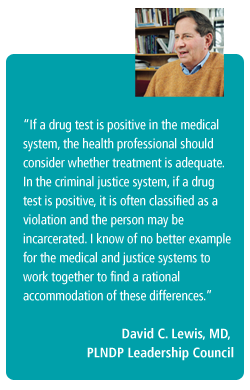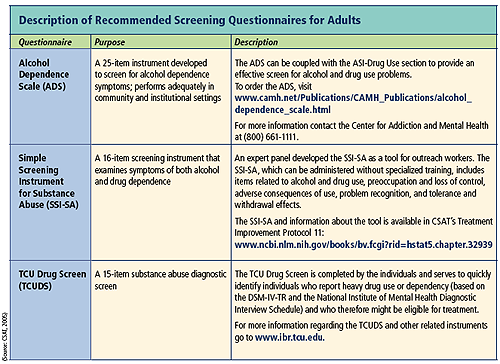

Research has shown that using evidence-based approaches is effective in identifying substance use disorders but NIDA’s Criminal Justice Drug Abuse Treatment Studies (CJ-DATS) found few community supervision agencies, jails, and prisons use them (Taxman et al., 2007c). If validated instruments were used, the justice system would be more likely to identify alcohol and other drug problems and define effective approaches to treat these problems thereby saving lives and money.
Screening is a process to evaluate whether an individual has an alcohol or other drug problem. Instruments used for screening must be standardized and evidence-based. Most effective screening instruments are confidential questionnaires that can be as brief as five questions. Research has established that clinical screening for alcohol and other drug problems should be a standard of care in a variety of settings, including emergency departments, trauma centers, and primary care, pediatrics, family practices, and the justice system. However, in the justice system, it is also important to gather collateral information, such as a drug test, police report, or conversation with family members, to appropriately identify an individual’s problem.
Studies indicate a high prevalence of individuals involved with the justice system have substance use disorders. Therefore it is recommended that everyone be screened as soon as they enter the justice system (Peters and Peyton 1998). Most justice staff can administer a screening questionnaire without extensive training.
When developing a screening protocol it is important to answer these questions:
- What is the purpose of the screening?
- What screening instruments/tools are best suited for clientele and environment where screen will be performed?
- Where, when, and how will the screening will be conducted?
- Who will administer the screening protocol?
- What happens with the results?
- How will confidentiality be maintained?

Examples of Evidence-Based Screening Questionnaires for Adults in the Criminal Justice System Alcohol Dependence Scale (ADS) |
The ideal screening instrument for the justice system must be standardized,
evidence-based, age-appropriate, and easy to use, particularly in busy courtrooms. Choosing the appropriate screening tool requires consideration of a number of factors, including:
- Client characteristics: age, gender, education, and ethnicity
- Environmental factors, like the setting within the judiciary (i.e. juvenile justice system, family court, criminal justice system, problem-solving courts)
If possible, screening for mental health disorders should occur at the same time as screening for substance use problems due to the high co-occurrence of both disorders. Because these disorders affect one another, simultaneous treatment is also the most effective approach.
Periodic screening during and after treatment, throughout an individual’s involvement with the justice system and as they transition back into the community is necessary to ensure that the appropriate levels and kinds of treatment are used in order to meet the individual’s needs and to avoid relapse.
| For more information on screening for co-occurring problems— See Section 4 |










